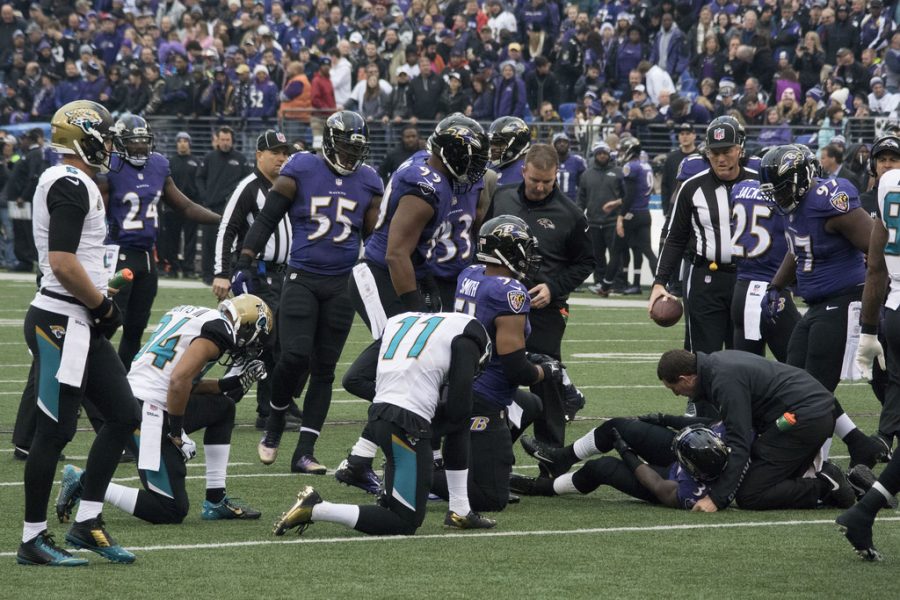The Dark Sides of Playing Football
Take a look at the negative effects that come along with playing football.
Photo provided by: Keith Allison
An NFL player from an injury and fellow players gather around.
Football in America is becoming more and more popular; approximately 1.2 million men in high school, college and the NFL strap on pads and helmets. While football is the most popular sport in America, this popularity is beginning to decline very quickly. The game is becoming more dangerous than Mixed Martial Arts, between physical and mental injuries, the sport now has many negative effects that come along with playing the game. If these effects are not corrected, they may take a terrible toll on this sport that is loved by so many players and fans. For the player, the three main negative effects of playing football are physical injuries, brain disorders, and depression.
When playing football as an adolescent, physical injuries are one of the most common effects. Physical injuries could include a pulled hamstring, a sprained ankle, broken bones and anything else that causes serious or permanent disfigurement. Physical injuries occur quite often, due to the intensity of the game; these football players put themselves at risk when they go out on the field. One of the most common injuries in football would be leg fractures, and Joe Theismann was one of those players who suffered from injury. Joe Theismann was at the top of his NFL career playing for the Washington Redskins, but on November 18, 1985, that would all come to an end. Theismann’s NFL career ended when he took a tackle from Lawrence Taylor; Theismann suffered from a comminuted compound fracture of his leg, meaning his leg was broken into many pieces, not just one break . Just like that, the game these men live and breath can be taken away from them just from one single tackle. While physical injuries vary in their severity, they are guaranteed to change the way you play for the rest of career, if you are lucky enough to still have a career. While physical injuries are definitely not anyone’s plan, they are unpredictable and may negative consequences for the remainder of one’s professional career.
Brain disorders, or anything having to do with damaging the brain, is next in line for the second most common negative effect of playing football. The most common brain injury is a concussion; this can be defined as a mild blow to the head which could possibly cause unconsciousness. Another brain disorder that is sadly becoming more prevalent in football players today is CTE, Chronic Traumatic Encephalopathy. CTE is an injury that has done so much damage to one’s brain that it eventually will start killing brain cells. Tyler Hilinski, the late quarterback of Washington State University, was recently diagnosed with CTE. Hilinski was at the top of his game at WSU, but that came with many hard hits and sacks that eventually lead to brain damage. In January of 2018, Hilinski took his own life and it shook the world of college football to the core. Like most cases, no one knew why Hilinski made this decision, but after running multiple tests on his brain, the truth came out. Hilinski had suffered from CTE, which caused his brain to be identical to brain of 60 year old man, even though he was just a young 21 year old man. High schools, colleges and the NFL have taken a closer look at how common these brain disorders have become. While brain disorders are not guaranteed if you play football, they are becoming more and more common and are definitely at the top of the list when it comes to the negative effects of playing football.
With the growing number of players being diagnosed with CTE, depression has also greatly increased. Depression is a disorder that causes great distress for a person. Playing football while dealing with the injuries, pressure, commitment and all sorts of other things, will create cause many players to become depressed. Mike Webster was a four time Super Bowl champion who played for the Pittsburgh Steelers is one of the most well known football players to deal with depression. After retiring from football after 16 years, Webster was diagnosed with depression. He did not take on the task of being depressed very well, as most people wouldn’t. Webster became homeless, began to live out of his car or at the train station; friends offered to help Webster out, he always declined and often disappeared. No one would know where he went, and sometimes neither did Webster, because he was depressed. When one is depressed, they begin to become someone they weren’t before the diagnosis and that’s what happened to Hall of Famer, Mike Webster. Webster’s life goes to show that even while you are at the top of your football career, injuries could happen which could then lead to depression which then could cause your whole life to be flipped upside down.
In conclusion, negative effects such as physical injuries, brain disorders and depression are becoming more and more common today in football players. While football is the heart of sports in the U.S., these negative effects need to be taken into consideration before it’s too late. With approximately 1.2 million men playing this sport, there needs to be a solution to these effects so these men can continue to play the game they love. With all of these negative effects in mind , is playing football really worth it?
Your donation will support the student journalists of Cypress Woods High School. Your contribution will allow us to purchase equipment and cover our annual website hosting costs.

